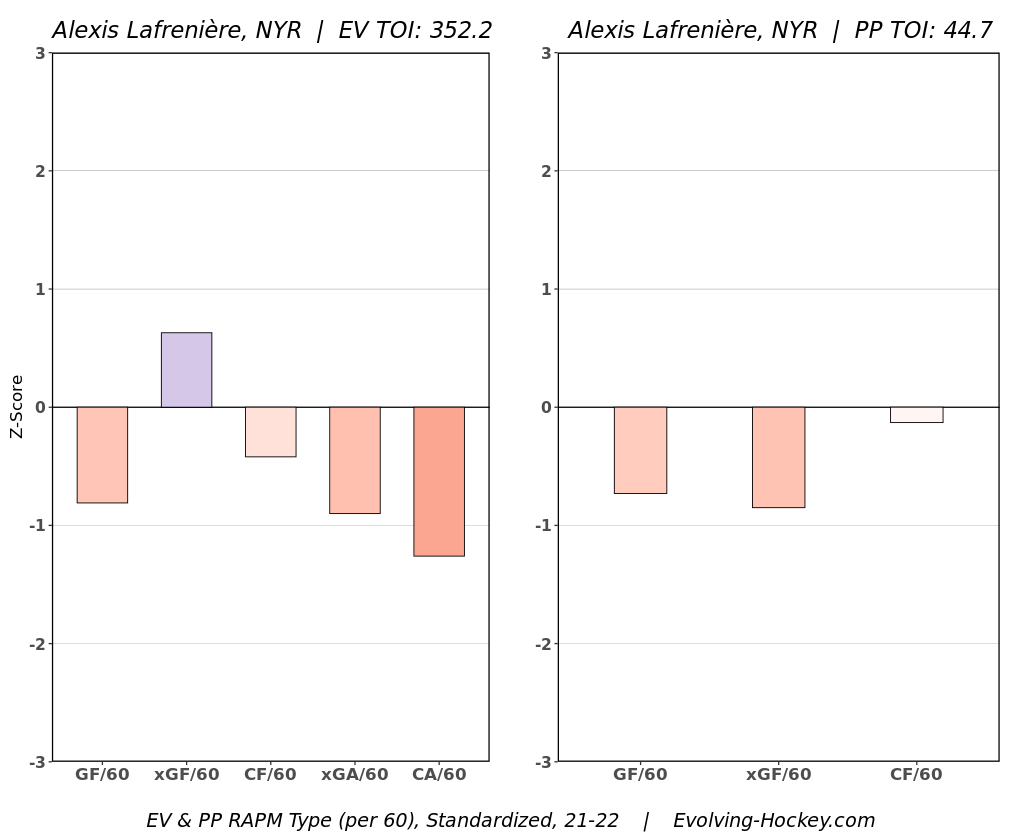
The first offseason of Chris Drury’s young career as GM of the Rangers was, putting it lightly, controversial. The moves he made had the overall goal of building out the bottom half of the roster while handing the top half to their pair of top-two picks. Kaapo Kakko and Alexis Lafreniere were to be tasked with replacing Pavel Buchnevich’s (and Colin Blackwell’s) production in the top six. The message was simple: This is their team now, and for the future. As they go, the team will go.
But the thing is, they haven’t gone. They simply have not scored, at least not consistently. Through 27 games, Kakko has five goals and 11 points. In 31 games, Lafreniere has six goals and eight points. Combined, that’s 11 goals and 19 points over the course of the season, a far cry from replacing Buchnevich’s production in the aggregate.
It’s not all bad – the process is there
While neither is putting up points the way we, or the team, had hoped, it’s not like either is playing poorly. There’s always room for improvement, but there is also reason to see the talent and optimism that comes with both kids.
For Kakko, we see top line peripherals for xGF/60, CF/60, and CA/60. He’s driving play offensively while remaining a solid defensive forward. Lafreniere doesn’t have the defensive numbers, which is fine, but his xGF/60 is in the blue. This suggests that both Kakko and Lafreniere are driving play. The red GF/60, which is far below their expected goals numbers, shows that there is a lack of finish while they are on the ice. This lack of finish impacts their numbers significantly.
When it comes to development, this shows hope and proper process. These kids are doing what they should be doing on the ice: Driving play, and helping create space offensively. The finish aspect is a complicated one. It is a product of both their finishing and their teammates’ finishing. Neither Kakko –shooting 11%– nor Lafreniere –shooting 15.8%– have career numbers to base their own shooting. It seems like Lafreniere is shooting just fine, while Kakko likely has some wiggle room to move up.
The Rangers’ on-ice SH% with Lafreniere is 6.63%, down two full percentage points from last year’s 8.73%. Kakko’s is 7.53%, playing mostly on the second line. So there is clearly a team finishing problem. You didn’t need me to tell you that though. The offense has been less than stellar at even strength. We knew this.
Producing on the score sheet
The process is there, which is good and bodes well for the future. But at some point, both Kakko and Lafreniere will need to produce on the score sheet. This means turning that red GF/60 bar into a blue line, and producing to their potential. It’s not to say they won’t, or that their development has been poor. It’s to say they will need to start seeing points while they are on the ice.
Hockey, unlike most other team sports, has a much greater emphasis on the team aspect than the individual. There are your superstars that can produce with whomever, whenever. Neither Kakko nor Lafreniere are those players, at least not yet. Their development, which as a reminder is not linear, is good thus far. But unless they produce, the Rangers won’t be true competitors.
There is no simple answer to this problem, though. You can’t wave a magic wand and all of a sudden have them putting up points. It should come sooner rather than later, as both kids are showing they drive play. The process is there, now we are waiting on the results. The ice time argument, especially for Lafreniere, is a valid one, but it is also a Catch-22. For Lafreniere to get more ice time, he needs to produce more. But for him to produce more, he likely needs more ice time.
This point was discussed by the BSB team, and we all came to the same conclusion. Lafreniere isn’t playing with scrubs. He has arguably two solid, if unspectacular, linemates at the moment in Filip Chytil and Julien Gauthier. He should be producing more, but he also should be getting more than 10 minutes a night at even strength.
The only solution, at the moment, is patience. Development is not linear.
Share:
More About:Players


